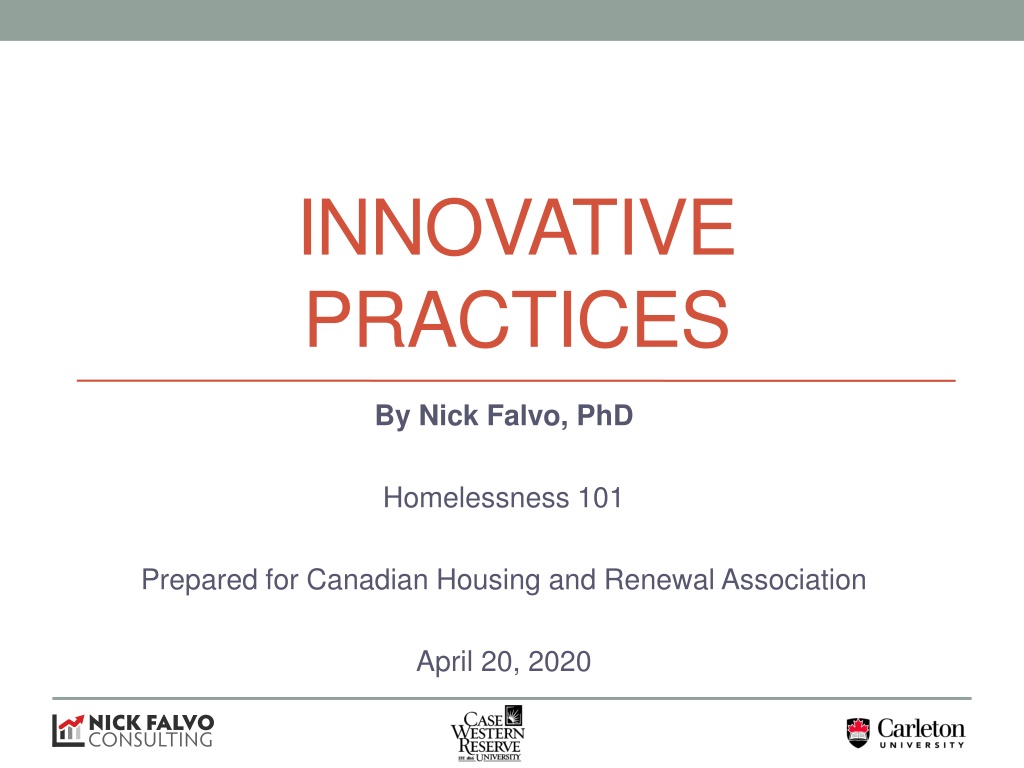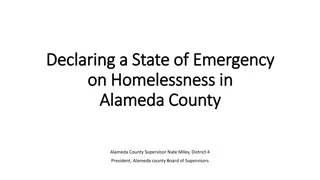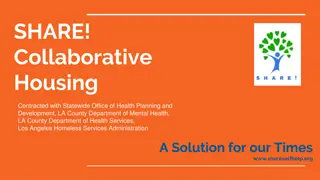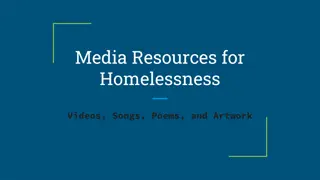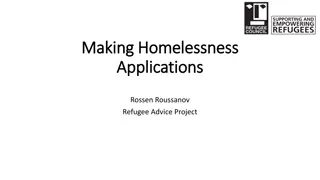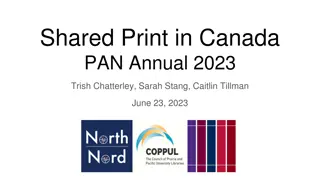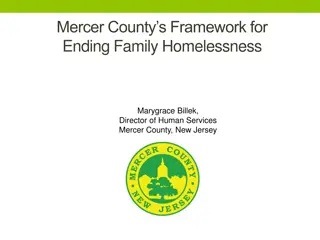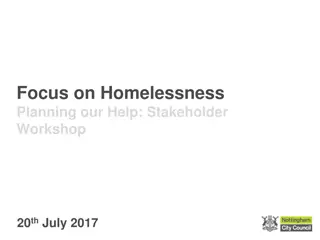Innovative Practices in Homelessness: A Canadian Perspective
Explore six innovative practices addressing homelessness in Canada, including modular supportive housing, removal of rent caps, adaptive case management, shelter diversion, housing-focused shelters, and artificial intelligence. These practices aim to provide efficient and effective solutions to combat homelessness by offering unique approaches to housing and support services.
Download Presentation

Please find below an Image/Link to download the presentation.
The content on the website is provided AS IS for your information and personal use only. It may not be sold, licensed, or shared on other websites without obtaining consent from the author. Download presentation by click this link. If you encounter any issues during the download, it is possible that the publisher has removed the file from their server.
E N D
Presentation Transcript
INNOVATIVE PRACTICES By Nick Falvo, PhD Homelessness 101 Prepared for Canadian Housing and Renewal Association April 20, 2020
Overview We re now going to talk about six innovative practices in homelessness, happening right now in Canada. My intention is not to make you love them; but nor is it to make you hate them. Rather, it is to bring you some information to which you may not have previously had access.
Overview (contd) 1. Modular supportive housing 2. Removal of the rent cap in NWT 3. Adaptive Case Management 4. Shelter diversion 5. Housing-focused shelters 6. Artificial Intelligence
Modular supportive housing This innovation is happening at the level of supportive housing development. Very low vacancy rates in Vancouver, and high rents. Some comm s have 0.5% vac rates. Landlords getting very choosy. Cost is similar to traditional way. The speed is the difference.
Modular supportive housing (contd) This can happen in 18 months, from the time funding is approved. Typically built somewhere else and then transported on flatbread trucks. Cranes lifts them. Built in a factory. There s one on Vancouver Island, and one in Edmonton.
Modular supportive housing (contd) A small % of it is repurposed modular. Most is new though. Typically 325 sq ft per unit. Focus is singles or couples. Washroom and small kitchen.
Modular supportive housing (contd) Common area and commercial kitchen, with a common meal (and continental breakfast) per day. All staffed 24-7. No housing readiness requirement.
Modular supportive housing (contd) Several of them have some overdose prevention services (recall BC Housing s approach to harm reduction, discussed earlier today). People can use safely and have peer witnessing programs. Admittedly, some prefer to use with their own peer networks in their own units, and that s an ongoing issue.
Modular supportive housing (contd) Thoughts?
Removal of the rent cap in NWT This innovation was led by a territorial government. In April 2018, the rent cap for single social assistance recipients without dependants was removed. Previously, this group (but not other household types) had been allocated a maximum of $900 per month for rent from social assistance funds, making it very difficult to find rental housing.
Removal of the rent cap in NWT (contd) But now, each social assistance recipient household is provided with a rental allowance large enough to secure a housing unit that meets nationally-accepted suitability standards. (Specifically, the standards in question are the National Occupancy Standards determined by the Canada Mortgage and Housing Corporation.)
Removal of the rent cap in NWT (contd) Now, it is not unheard of for a single employable social assistance recipient without dependants to have the rent for a $1,500/month one-bedroom housing unit fully covered by the rental portion of their social assistance benefits. No diagnosed disability is required.
Removal of the rent cap in NWT (contd) This has been very positively received by many people in community (notwithstanding the fact that for-profit landlords still generally prefer to rent to tenants who are employed).
Removal of the rent cap in NWT (contd) Thoughts?
Adaptive Case Management This innovation is being led by a system planner. Calgary Homeless Foundation funds agencies to support clients experiencing homelessness and get them into housing very quickly.
Adaptive Case Management (contd) Options include Intensive Case Management (ICM). ICM has a 10:1 client-staff ratio, which translates into 16 hours of staff support per month. In late 2015, CHF introduced something called Adaptive Case Management (ACM).
Adaptive Case Management (contd) With ACM, it s a loosening of this ratio, saying we ll incentivize an organization to house a lot of clients quickly, instead of incentivizing you to take on a fixed ratio indefinitely. ACM uses scattered site approach.
Adaptive Case Management (contd) As of fall 2018, Calgary was seeing considerable success in housing individuals and families via ACM. Compared with ICM, people in ACM get housed very quickly (in fact, a bit more quickly). Also, people housed in ACM remain housed for about as long as those housed via ICM.
Adaptive Case Management (contd) This program targets any acuity of individuals or families. Key question CHF was asking: are you sure you need to take this much time with a client?
Adaptive Case Management (contd) CHF pays after the fact on a fee-for-service model. The client must be housed in order for funding to flow for that person. As long as a lease is signed, funding flows from CHF.
Adaptive Case Management (contd) Recall this from this morning: CHF funds permanent place-based supportive housing (highest acuity) $35- $40K per person per year, and that does not include capital cost (i.e. up front costs on building). By contrast, ACM would pay $5K per year for some people and get them housed ($2,500 to get them in, including damage deposit and move-in costs + three months of rent supps).
Adaptive Case Management (contd) ACM is being evaluated as we speak. CHF certainly views it as promising.
Adaptive Case Management (contd) Thoughts?
Shelter diversion (Region of Waterloo) This innovation is being led by a system-planner. My own definition of shelter diversion is the process of discouraging the over-use of emergency shelters. Family diversion has been going on in the Region of Waterloo for 5-6 years. They have a housing help line run by Lutherwood (a local non-profit). That s run during 8:30-4:30PM (M-F).
Shelter diversion (Region of Waterloo) There s a family-specific shelter that a family in need of shelter can show up at outside of those hours. The family would then encouraged to call the telephone line the next morning. Region of Waterloo then started this in 2018 in a meaningful way in youth sector. One particular organization initiated this. Argus took the lead on this. They specialize in youth work.
Shelter diversion (Region of Waterloo) Diversion in the Region of Waterloo has been expanded to single adults (also led by Argus) in 2019. Argus runs a telephone service. Hours: 8AM till midnight. Two staff on at all times. Between midnight and 8Am, a person can go to a shelter. Next morning they d be asked to call the prevention and diversion line.
Shelter diversion (Region of Waterloo) Staff on the phone can do a proper intake and ask a lot of questions. A front-line staff person at a shelter is often busy administering the services.
Shelter diversion (Region of Waterloo) If someone is known to the shelters, they can show up at a shelter and not necessarily go through the prevention and diversion telephone line. But if someone s new to the system, they need to go through the telephone line. Officials are still working out who exactly should have to go through the phone line first.
Shelter diversion (Region of Waterloo) Funding: Staff with the prevention and diversion lines have access to funding for both transportation and food vouchers. They can arrange plane tickets to NL. They can arrange bus trips. This is for families, singles and youth. Lots of one-way travel tickets paid for. Staff make sure it s a safe place.
Shelter diversion (Region of Waterloo) Maybe connecting someone with a grandparent they haven t spoken to in awhile. Much of it has to do with returning someone to home community. Sometimes officials provide food vouchers.
Shelter diversion (Region of Waterloo) Thoughts?
Housing-focused shelters This innovation is being led by an emergency shelter. Note: Calgary has high rental vacancy rates, relative to other cities. As of October 2019, it was 3.9% (all types of private units combined). Toronto s was 1.5%. Ottawa s was 1.8%. Vancouver s was 1.1%.
Housing-focused shelters (contd) The Calgary Drop-In (DI) consistently sees 100 new people per month asking for overnight accommodation. Prior to 2017, overnight accommodation was provided on the spot, with very few questions asked.
Housing-focused shelters (contd) Now, staff track each person s path quite closely. Most gain physical access, but they re assigned a housing worker immediately. A housing plan is put in place within a day.
Housing-focused shelters (contd) DI has announced itself as a housing-focused organization. They are now neurotically focused on housing. Staff have lanyards.
Housing-focused shelters (contd) Staff on a regular basis are striking up conversations with residents about where they re at with housing searches. Each staff has a lanyard and frequently gets a new one, with new tips on how to communicate with residents on this.
Housing-focused shelters (contd) Direct quote: Anything comfortable that was making people want to stay in shelter, we shut it down. We stopped doing any and all activities not related to housing. We called this positive disruption. This was not easy internally. Culture change and change management is fundamental to this. We shut off the TVs, closed down the library. Now we call the library a housing hub. We took out all the books. We used to get 1,200 people ON each night, now it s 700.
Housing-focused shelters (contd) Thoughts?
Artificial Intelligence This innovation is being led by university-based researchers. Recall our convo this morning re: uncertainty re: how to respond to each type of homelessness.
Artificial Intelligence (contd) Artificial Intelligence (AI) is a type of computing that produces answers to questions answers that are different and often superior to those that human intelligence is able to provide.
Artificial Intelligence (contd) It allows computers to perform human tasks. It can be used to provide advice or guidance. AI can provide the probability of a certain approach to homelessness having a successful outcome, based on the past experiences of thousands or tens of thousands of similar people having been in similar situations in the past.
Artificial Intelligence (contd) Examples: Self-driving cars Facial recognition Google Translate Robots performing unsafe tasks done by humans (e.g. carrying equipment in rough terrain, planning Mars rover actions).
Artificial Intelligence (contd) AI is often used for tedious but well-defined human tasks. For example: scheduling hospital resources, airplane schedules
Artificial Intelligence (contd) In the homelessness sector, all examples of Ai are in the research stage for now.
Artificial Intelligence (contd) In Dr. Latimer s project, probabilities are calculated of a person moving from one state to another (based on AHCS data). So from homeless to housing to homeless, etc. They re focusing on Montreal right now.
Artificial Intelligence (contd) He s also got another student whose matching homeless ppl to the appropriate resource (ironic, considering what we talked about earlier today). A homeless person with a platform could access a platform, input their info, and then be offered a policy response.
Artificial Intelligence (contd) If they don t have a smart phone, a staff person can log in and plus that person s data into an app that will connect them to the policy response.
Artificial Intelligence (contd) Computer scientists are typically involved in this. Recommendations for person s care are made based on past successes (i.e., successful outcomes). This is based on what worked with other people with similar characteristics.
